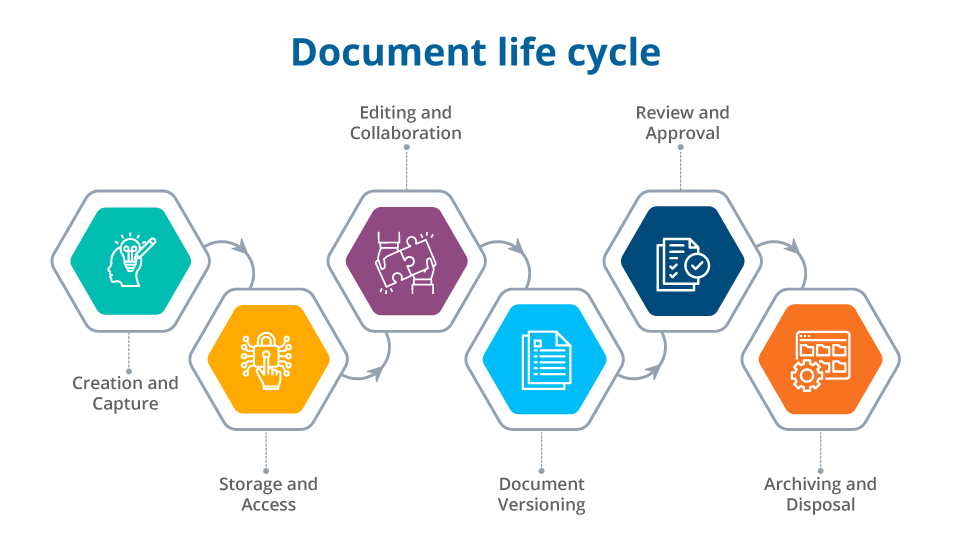Introduction to Enterprise Document Management
In today’s fast-paced business environment, managing the ever-growing volume of documents and data has become a critical challenge for organizations of all sizes. Enterprise Document Management (EDM) has emerged as a vital solution to this problem, offering a systematic approach to handling an organization’s documents and records efficiently.
What is Enterprise Document Management?
Enterprise Document Management refers to the process of capturing, storing, organizing, and retrieving documents and information within an organization. It goes beyond simple file storage, encompassing a comprehensive strategy for managing the entire lifecycle of documents, from creation to archival or deletion.
In 2025, EDM has become an indispensable tool for businesses looking to streamline their operations, enhance productivity, and maintain a competitive edge in the digital landscape. With the increasing adoption of remote work and the need for instant access to information, EDM systems have evolved to meet these changing demands.
The Evolution of Document Management
To truly appreciate the value of modern EDM systems, it’s essential to understand their evolution:
1. Paper-based systems: Traditionally, businesses relied on physical filing cabinets and manual document organization.
2. Basic digital storage: The advent of computers led to the digitization of documents, but organization remained a challenge.
3. Document Management Software: Early software solutions offered basic digital file organization and search capabilities.
4. Enterprise Content Management (ECM): A more comprehensive approach that included workflow management and collaboration tools.
5. Cloud-based EDM: The current era, where documents are accessible from anywhere, with advanced features like AI-powered search and analytics.
This progression has led us to the sophisticated EDM systems we see in 2025, which offer unprecedented levels of efficiency and functionality.
Why Is Enterprise Document Management Important?
The importance of Enterprise Document Management cannot be overstated in today’s digital-first business landscape. Let’s explore the key reasons why EDM has become a critical component for organizations in 2025.
Improve Efficiency and Productivity
One of the most significant benefits of implementing an EDM system is the dramatic improvement in efficiency and productivity. Here’s how:
– Instant document retrieval: Employees can find the information they need in seconds, rather than sifting through physical files or poorly organized digital folders.
– Streamlined workflows: Automated processes reduce manual tasks, allowing staff to focus on high-value activities.
– Reduced errors: With version control and clear audit trails, the risk of working with outdated or incorrect documents is minimized.
– Collaboration enhancement: Teams can work on documents simultaneously, regardless of their physical location.
A study by McKinsey found that employees spend an average of 1.8 hours every day searching and gathering information. EDM systems can significantly reduce this time, potentially saving organizations thousands of hours annually.
Enhance Data Security and Compliance
In an era where data breaches and regulatory fines can cripple a business, EDM plays a crucial role in maintaining security and compliance:
– Access control: EDM systems allow for granular permission settings, ensuring that only authorized personnel can view or modify sensitive documents.
– Audit trails: Every interaction with a document is logged, providing a clear record for compliance and forensic purposes.
– Data encryption: Advanced EDM solutions offer robust encryption for documents both in transit and at rest.
– Regulatory compliance: Features like retention policies and automated compliance checks help organizations adhere to industry-specific regulations such as GDPR, HIPAA, or SOX.
Consider this: According to an IBM report, the average cost of a data breach in 2024 was $4.35 million. EDM systems serve as a critical line of defense against such costly incidents.
Reduce Operational Costs
The financial benefits of implementing an EDM system are substantial and multifaceted:
– Decreased storage costs: By digitizing documents, businesses can significantly reduce or eliminate the need for physical storage space.
– Reduced paper and printing expenses: Digital documents cut down on paper, ink, and printer maintenance costs.
– Time savings: The efficiency gains translate directly into cost savings through improved productivity.
– Lower risk of fines: By ensuring compliance, organizations reduce the risk of costly regulatory penalties.
A case study by Gartner revealed that a mid-sized company saved over $250,000 annually after implementing an EDM system, primarily through reduced storage costs and improved productivity.
Key Features of Effective Document Management Systems
To fully leverage the benefits of Enterprise Document Management, it’s crucial to understand the key features that make these systems effective. In 2025, advanced EDM solutions offer a range of powerful capabilities:
Document Capture and Indexing
Modern EDM systems excel at converting physical documents into digital formats and organizing them efficiently:
– Optical Character Recognition (OCR): This technology allows for the conversion of scanned documents into searchable text, making it easier to find information within documents.
– Automated metadata extraction: AI-powered systems can automatically tag documents with relevant metadata, improving organization and searchability.
– Bulk import capabilities: Large volumes of documents can be quickly ingested and processed, saving time during system setup or migration.
For example, a legal firm implementing an EDM system with advanced OCR capabilities reported a 40% reduction in document processing time, allowing lawyers to focus more on case analysis and client interaction.
Search and Retrieval Functions
The ability to quickly find the right document is at the heart of any effective EDM system:
– Full-text search: Users can search for specific words or phrases within documents, not just titles or metadata.
– Natural language processing: Advanced systems understand context and can interpret complex search queries.
– Federated search: This feature allows users to search across multiple repositories or even external sources from a single interface.
A video demonstration of modern EDM search capabilities shows how users can find relevant documents in seconds, even in repositories containing millions of files.
Workflow Automation
Automation is a key component of EDM systems, streamlining processes and reducing manual intervention:
– Document routing: Automatically send documents to the right people for review or approval.
– Task management: Assign and track tasks related to document processing or review.
– Conditional workflows: Create complex workflows that adapt based on document content or user actions.
– Integration with other business systems: Connect EDM workflows with CRM, ERP, or other enterprise software for seamless operations.
A manufacturing company implementing workflow automation in their EDM system reported a 60% reduction in purchase order processing time, leading to improved supplier relationships and cost savings.
Collaboration Tools
In 2025, with remote and hybrid work models being the norm, collaboration features are more important than ever:
– Real-time co-authoring: Multiple users can edit documents simultaneously, seeing each other’s changes in real-time.
– Version control: Track changes, compare versions, and easily revert to previous document states if needed.
– Comment and annotation: Users can leave feedback directly on documents, facilitating discussion and review processes.
– Integration with communication tools: Seamless connections with platforms like Microsoft Teams or Slack for instant discussions about documents.
These collaboration tools have become essential in maintaining productivity in distributed teams. A survey by PwC found that 83% of employers now say the shift to remote work has been successful for their company, largely due to effective digital collaboration tools.
Implementing an Enterprise Document Management System
Successfully implementing an Enterprise Document Management system requires careful planning and execution. Here’s a guide to help organizations navigate this process effectively in 2025:
Assessing Business Needs
Before selecting an EDM system, it’s crucial to thoroughly evaluate your organization’s specific requirements:
1. Document volume and types: Assess the quantity and variety of documents your organization handles.
2. User needs: Understand how different departments and roles interact with documents.
3. Compliance requirements: Identify industry-specific regulations that your EDM system must address.
4. Integration needs: Determine which existing systems your EDM solution should connect with.
5. Scalability: Consider future growth and how the EDM system can accommodate increasing demands.
Conducting a comprehensive needs assessment helps ensure that the chosen EDM solution aligns with your organization’s goals and processes.
Choosing the Right Software
With numerous EDM solutions available in 2025, selecting the right one for your organization is critical:
– Cloud vs. On-premises: Decide whether a cloud-based solution or an on-premises system is more suitable for your needs.
– Vendor reputation: Research potential vendors, looking at their track record, customer reviews, and industry recognition.
– Feature set: Ensure the chosen solution offers all the necessary features identified in your needs assessment.
– User interface: Look for systems with intuitive interfaces to minimize the learning curve for your team.
– Support and training: Consider the level of support and training offered by the vendor.
It’s often helpful to request demos or trial periods from multiple vendors to get a hands-on feel for different systems. The Capterra software comparison platform can be a valuable resource for evaluating different EDM solutions.
Preparing for Data Migration
Data migration is often the most challenging aspect of implementing a new EDM system. Here’s how to approach it:
1. Data audit: Catalog existing documents and their current storage locations.
2. Clean-up: Remove redundant or outdated documents to streamline the migration process.
3. Mapping: Create a clear plan for how existing data will map to the new system’s structure.
4. Testing: Conduct thorough tests with a subset of data before full migration.
5. Verification: After migration, verify data integrity and accessibility in the new system.
Remember, successful data migration is crucial for user adoption and the overall success of your EDM implementation.
Training and Change Management
Even the best EDM system will fail if users don’t adopt it. Effective training and change management are essential:
– Develop a comprehensive training program: Offer a mix of in-person, virtual, and self-paced learning options.
– Create user guides and FAQs: Provide easily accessible resources for users to reference.
– Identify champions: Train power users who can support their colleagues and promote system adoption.
– Communicate benefits: Clearly articulate how the new system will make employees’ jobs easier and more efficient.
– Gather feedback: Continuously collect user feedback to address issues and improve the system over time.
A phased rollout approach can be effective, allowing you to address issues with a smaller group before company-wide implementation.
Challenges in Enterprise Document Management
While Enterprise Document Management offers numerous benefits, organizations may face several challenges during implementation and ongoing use. Understanding these challenges is crucial for developing effective strategies to overcome them.
User Adoption
One of the most significant hurdles in EDM implementation is getting users to embrace the new system:
– Resistance to change: Many employees are comfortable with existing processes and may resist learning new ones.
– Complexity: If the system is not user-friendly, it can discourage adoption.
– Lack of understanding: Users may not fully grasp the benefits of the new system.
To address these issues:
– Involve users in the selection process to ensure the chosen system meets their needs.
– Provide comprehensive training and ongoing support.
– Demonstrate clear benefits and how the system makes their jobs easier.
– Consider gamification elements to make learning and using the system more engaging.
Security Concerns
While EDM systems enhance document security, they also introduce new security considerations:
– Data breaches: Centralized document storage can be an attractive target for cybercriminals.
– Insider threats: Employees with access to sensitive documents may misuse their privileges.
– Compliance violations: Improper document handling can lead to regulatory non-compliance.
Mitigating these risks requires:
– Implementing robust access controls and encryption.
– Regular security audits and penetration testing.
– Continuous employee training on security best practices.
– Staying updated on the latest security threats and countermeasures.
For insights on the latest document security trends, check out this video on cybersecurity in document management.
Integration Issues
Integrating an EDM system with existing technologies can be complex:
– Legacy system compatibility: Older systems may not easily connect with modern EDM solutions.
– Data silos: Different departments may use various software that doesn’t communicate well with the EDM system.
– API limitations: Some systems may have restricted APIs, limiting integration possibilities.
To overcome these challenges:
– Choose EDM systems with robust API capabilities and a track record of successful integrations.
– Work closely with IT teams and vendors to develop custom integrations where necessary.
– Consider middleware solutions to bridge gaps between systems.
– Plan for a phased integration approach to manage complexity and minimize disruption.
Future Trends in Enterprise Document Management
As we look ahead in 2025, several emerging trends are shaping the future of Enterprise Document Management. These innovations promise to make EDM systems even more powerful and indispensable for businesses.
Artificial Intelligence and Machine Learning
AI and ML are revolutionizing EDM in several ways:
– Intelligent document classification: AI can automatically categorize and tag documents based on content, improving organization and searchability.
– Natural language processing: Advanced systems can understand context and intent, making searches more intuitive and accurate.
– Predictive analytics: ML algorithms can analyze document usage patterns to predict which documents users may need, improving efficiency.
– Automated data extraction: AI can pull relevant information from unstructured documents, populating databases and triggering workflows automatically.
For example, a legal firm implementing AI-powered EDM reported a 30% reduction in time spent on document review processes, allowing lawyers to focus on higher-value tasks.
Mobile Document Management
With the continued rise of remote and hybrid work models, mobile access to EDM systems is no longer just a convenience—it’s a necessity:
– Responsive design: EDM interfaces are optimized for various screen sizes and devices.
– Offline access: Users can view and edit documents even without an internet connection, with changes syncing once reconnected.
– Mobile-specific features: Touch-friendly interfaces, voice commands, and mobile camera integration for document capture.
– Enhanced security: Advanced mobile security features like biometric authentication and remote wipe capabilities.
A survey by Gartner predicts that by 2026, 60% of knowledge workers will be working remotely, underscoring the importance of robust mobile EDM capabilities.
Blockchain for Document Integrity
Blockchain technology is emerging as a powerful tool for ensuring document authenticity and traceability:
– Immutable audit trails: Every document interaction is recorded on the blockchain, creating an unalterable history.
– Smart contracts: Automated, blockchain-based contracts can trigger actions based on document states or conditions.
– Enhanced security: Decentralized storage and cryptographic protection make documents highly resistant to tampering or unauthorized access.
– Simplified compliance: Blockchain can automate and streamline regulatory compliance processes.
While still in its early stages for EDM, blockchain shows promise for industries where document authenticity is critical, such as legal, finance, and healthcare.
Integration with Internet of Things (IoT)
The growing IoT ecosystem is opening new possibilities for EDM:
– Automated document creation: IoT devices can generate and file reports automatically, reducing manual data entry.
– Context-aware access: Physical location or device status can influence document access permissions.
– Enhanced tracking: IoT-enabled tags can track physical documents, bridging the gap between digital and physical document management.
For instance, a manufacturing company using IoT-integrated EDM reported a 40% improvement in equipment maintenance efficiency by automating the creation and routing of maintenance reports based on sensor data.
Conclusion
As we’ve explored throughout this comprehensive guide, Enterprise Document Management has become an indispensable tool for businesses in 2025. The benefits of implementing a robust EDM system are clear: improved efficiency, enhanced security, reduced costs, and better compliance. However, the journey to successful EDM implementation requires careful planning, the right technology choices, and a commitment to overcoming challenges like user adoption and integration issues.
Looking to the future, the integration of AI, mobile technologies, blockchain, and IoT promises to make EDM systems even more powerful and transformative for organizations. These advancements will not only streamline document management processes but also unlock new ways of working and collaborating.
For businesses yet to embrace EDM, the time to act is now. The competitive advantage offered by efficient document management cannot be overstated in our increasingly digital world. For those already using EDM systems, staying abreast of emerging trends and continuously optimizing your processes will ensure you remain at the forefront of operational excellence.
Remember, the goal of Enterprise Document Management is not just to manage documents more effectively, but to empower your organization to work smarter, faster, and more securely. By leveraging the right EDM solution and staying committed to best practices, you can position your business for sustained success in the digital age.
Are you ready to take your document management to the next level? Whether you’re looking to implement a new EDM system or optimize your existing processes, expert guidance can make all the difference. Contact us today for a personalized consultation and discover how we can help you harness the full power of Enterprise Document Management for your business.


